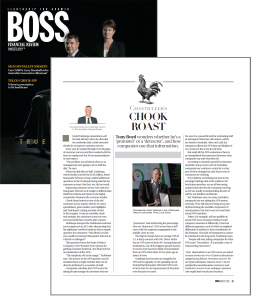AFR, 5 AUGUST 2015
 David Tudehope remembers well the bad old days when he did what the textbooks said a chief executive should do to improve customer service.
David Tudehope remembers well the bad old days when he did what the textbooks said a chief executive should do to improve customer service.
Every year he waded through 70 to 80 pages of customer surveys and then worked with his team to implement the 36 recommendations in each report.
“The problem was all about what we as management were going to do to shift the dial,” he says. When the dial did not shift, Tudehope, whose family controls the $126 million, listed Macquarie Technology Group, added additional questions to the 50 already being asked in the customer surveys.
But that, too, did not work. Improving customer service was critical to Macquarie Telecom as it sought to differentiate itself from Telstra and Optus in the highly competitive business telco services market. Chook Roast looked at one of the old customer survey reports with its A3-sized spreadsheet, green marker pen highlights and Tudehope’s cutting remarks written in the margins.
It was an unwieldy, deadend strategy: the customers were not even surveyed until three months after contact.
Tudehope dumped the traditional customer survey approach in 2012 after discovering that his nightmare could be replaced with a simple question for customers: “How likely is it that you would recommend Macquarie Telecom to a friend or colleague?”
This question forms the heart of Bain & Company’s Net Promoter Score system for gaining customer feedback. “The simplicity of it is the magic,” Tudehope says.
The answer to the NPS question can be translated into a single number that can be directly attributed to a member of staff. Companies calculate their NPS scores by taking the percentage of customers who are “promoters” and subtracting the percentage who are “detractors”.
NPS scores form a bell curve with the majority congregated in the middle, close to zero. The big four banks have an average NPS of 1.5, a sharp contrast with ING Direct which has an NPS score of about 40. Among financial institutions, one of the biggest upward movers in recent years has been Bank of Queensland from an NPS of less than 10 two years ago to about 30 now.
Tudehope has become an evangelist for NPS and is regularly on the speaking circuit trumpeting Macquarie Telecom’s NPS score of 56 at June 30, an improvement of 40 points over the past two years.
He says it is a powerful tool for motivating staff in Macquarie Telecom’s call centres, which are based in Australia.
After each call, the company collects the NPS data and displays it on a screen in the room in real time.
But amid all this NPS exuberance there is an unexplained disconnection between what companies say and what they do. According to research quoted by Insurance Australia Group, 92 per cent of Australian companies say customer-centricity is a key part of their strategy but only 30 per cent of customers are noticing.

If you believe everything you hear in the earnings briefings and at the endless CEO lunchtime speeches, we are all becoming unpaid advocates for the companies serving us. We are madly recommending all sorts of stuff to our families and friends.
But Tudehope says too many Australian companies are not taking the NPS system seriously. They talk about it being a key part of determining the variable component of remuneration, but don’t want to reveal their actual NPS numbers.
Telstra, for example, will not publish its actual NPS score, because it believes each company measures it differently. It has five different segments, each of which is weighted differently in relation to their contribution to the business. That lack of transparency cannot be sustained in the long term, Tudehope says. “People will start asking companies for their NPS score,” he predicts. “It is actually a way of empowering customers.”
Respondents to an NPS survey are asked to assess service on a 0-to-10 point scale and are categorised as follows: Promoters (score 9-10) are loyal enthusiasts; Passives (score 7-8) are satisfied but unenthusiastic customers; and Detractors (score 0-6) are unhappy customers who might bad-mouth your business.
Check out the video for a more detailed explanation of what NPS actually stands for.
 David Tudehope remembers well the bad old days when he did what the textbooks said a chief executive should do to improve customer service.
David Tudehope remembers well the bad old days when he did what the textbooks said a chief executive should do to improve customer service.

